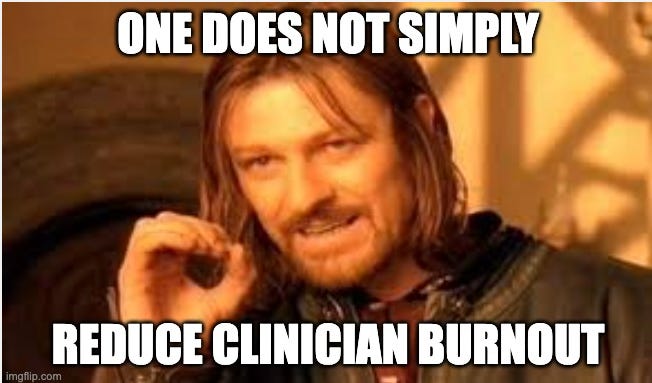Level up your evidence comms. How do you tell your story in a way that moves people?
Reflections on good comms from my podcast conversation with healthtech comms titan, James Somauroo of SomX.
You've built a great product. You've implemented it in the field, worked with communities and clinicians, nailed your clinical study and created measurable impact.
Policy makers. You’ve engaged, synthesized, analyzed with rigor. You’ve finally written your policy document. You've engaged with stakeholders, published in respected journals, and earned citations. Yet despite all this evidence, people haven't bought into it the way you’d hoped.
It lands flat. The sales pitch to the buyer had a tepid reaction. The funder is lukewarm. “We’ll get back to you”.
You built it, but they did not come.
Over the years, leading delivery teams for a digital health product that served millions or users globally and integrated into health systems across the world, I’ve lived this challenge.
What I've learned the hard way is that the unlock lies in how you connect with people on an emotional and psychological level and back it up with your product and hard data.
This is what we wrestled with on the Global Perspectives on Digital Health podcast, with a real expert in health tech comms. James Somauroo has built one of the biggest Healthtech media and comms agencies around with SomX, serving the biggest names in digital health and life sciences.
It was so valuable to get his insights and we talked at length on how to overcome these challenges.
Biggest takeaways for digital health companies
Here are some key insights that I thought were really valuable and here’s a video snippet.
Logic and evidence needs a psychological wrapper
We talked about Rory Sutherland’s framing in his book, Alchemy. Whilst people like to believe they make decisions based on evidence, what's actually happening in their brains is more complex. They get a feeling first, an emotional connection with what you're doing, and then retroactively seek objective measures to justify that feeling.
How do you weave together the logic of data, evidence, and hard numbers with qualitative storytelling that truly moves people?
This challenge is particularly acute for those building solutions with underserved communities worldwide. Often lacking substantial communications budgets or access to professional agencies, innovators in this space face additional hurdles, and repetitive, obscure funding cycles. Funders typically focus on hard metrics, asking "What measurable outcomes will you achieve?" While some attempt to weave in qualitative elements, it fails to connect.
As a result, healthcare workers and communities remain skeptical, communities withhold trust, and investors see just another pitch among hundreds—unable to distinguish your solution from the crowd.
James shares a great way to approach problem and build a comms plan that works.
Forget the standard pitch playbook
Investors and donors look at hundreds of pitch decks.
Most people fail to stand out because they go with the tried, tested method of problem, solution, TAM, etc and it just doesn’t land.
So what does get you noticed? James talked about leading with your unique story. That’s what makes you remarkable and gets someone to connect.
Academic journals, yes. But then what?
Academic journals have the most innovative stuff in existence, fact.
And yet, they are presented in the most boring way possible
James Somauroo, SomX
This quote has resonated with a lot of people. James talked about this being an opportunity to tell a story, engage people, surprise them like the astrophysicists of TikTok. Here’s an example with Dr Kirsten Banks.

 Tiktok failed to load.
Tiktok failed to load.Enable 3rd party cookies or use another browser
How can you turn your evidence into a more engaging narrative? That is the start of a comms plan.
Think Second and Third-Order Effects for your audience
The most powerful lesson from our conversation was this: focus on the second and third-order effects of your work on the people you care about.
Don't just present the immediate data points and outcomes. Consider what these mean emotionally to your specific audience.
James gave the example of McDonald's advertising. Their ads rarely mention taste or a full belly, the obvious first-order effects. Instead, they show someone enjoying their meal in a car while seagulls peer through the window, creating an emotional connection around being the subject envy of others. Many, in that context, relate to that feeling.
When driving toward a clinical outcome, ask yourself: what does success really mean to your audience? What deeper needs does it address for them?
A Pitfall to Avoid
There's a critical balance to strike. While it's tempting to jump straight to grand outcomes like "solving burnout," remember that you need to actually show that you actually change this. Stay within your locus of control, and ensure your claims and stories are backed up by what you deliver. Burnout has a myriad range of contributing factors, you if you shout about this, you might be over-reaching with your claims.
It’s not just about selling and getting the deal over the line.
It is also delivering a promise (and hopefully even delighting) your users and clients.
The key is creating logical steps from your measurable outcomes to those second and third-order effects, showing how you contribute to the bigger picture. So with burnout, for example, you're not claiming your solution will single-handedly solve burnout, but with the right proxies you're demonstrating how it helps people get there.
I’ve helped some great clients recently who have really leaned into this, with better engagement and success with sales prospects and potential investors.
What good looks like here is having commercial, product marketing, technical and clinical folk getting on the same page, and driving in the same direction.
Whoa. Thanks for making it this far. Found this useful? Share it with a friend or colleague! What resonated? Leave a comment.
👋 Hey, I’m Dr Shubs Upadhyay. I help digital health companies and investors integrate pragmatic clinical leadership that balances business goals and real healthcare impact. I’ve lived the challenges of scaling a digital health company with strong clinical leadership, and I care about what it takes to have impact for all.
I’ve worked as a senior, independent clinician in both high and low resource settings, led product and tech teams for a scaling digital health company serving millions of patients globally and created clinical evaluation frameworks for AI in healthcare with the World Health Organization. I’ve got a unique blend of clinical, industry and policy leadership and am a leading voice in global digital health for underserved communities.
Need help embedding clinical leadership and quality whilst still succeeding commercially?
Want to increase impact toward underserved communities as a digital health company or investor?
Need guidance communicating your impact in a way that resonates with clinical stakeholders?
Work with me. Get in touch on hello@shubs.me




